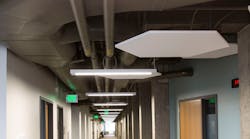For many, when considering advanced lighting control options beyond a simple on-off switch, the perception can be that it increases installation costs, adds complexity to projects, and will be time consuming. However, those are misconceptions. In addition to ongoing financial savings from reduced energy consumption, buildings’ installers, owners, and occupants see substantial benefits that range from set up to post installation.
Luminaire level lighting controls (LLLCs) have integrated wireless daylight and occupancy sensors and each luminaire is individually addressable, allowing independent control and programming. With this technology, manufacturers have embraced this opportunity to provide electrical contractors simple systems that make it easier to sell, design, order, install, and program.
Manufacturers want to create loyalty to their product, and with familiarity comes confidence. So, they have scaled down LLLC system components, simplified product offerings, and created new online-mobile training and education tools to broaden and support product knowledge.
Exactly how does all of this really help lower installation costs?
- We can identify significant labor savings with code-required controls already embedded into the fixture when they come from the factory, eliminating the ordering, coordination, and installation of separate components.
- Integration of wireless controls means less wiring, which simplifies the installation process. This can be highly beneficial for retrofits, where hardwiring can be difficult and time intensive.
- Next, setup time is reduced with simple programming in the app (installed on your mobile device), and some are already pre-programmed from the factory.
- If every fixture has LLLCs, the installer simply powers the luminaires. Typically, the factory pre-set settings activate daylight harvesting and occupancy as required by code.
- If the space needs to change in the future, each fixture can be easily re-programmed, providing a futureproof solution for the owner and occupants.
- Wireless LLLCs can also be powered by any available power circuit, so the installer can adapt onsite as needed.
All these labor savings are now being recognized. In fact, manufacturers are starting to provide contractor-based bidding software that will build a bill of material, pricing, and installation information for any project. This same service and support also are likely available from the control’s division of your local manufacturers’ representative. They commonly offer this assistance to ensure that you are not over-bidding labor. This all demystifies a process that in the past commonly led to the problematic issue of overbidding and losing the project.
Electrical contractors that have started specifying and installing LLLCs are quickly building confidence in this technology and promoting the value to their customers. LLLC makes lighting controls simple, wireless, and adaptable, all while helping you lower labor costs and, in many cases, allows you to meet energy code right out of the box.
Dan Kuhl is a certified instructor for the Building Operator Certification (BOC) program. He specializes in delivering turn-key trainings for industry partners including market research, content development and innovative supplemental materials designed to engage participants. He can be reached at [email protected].



